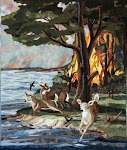Where do I find my ideas for my work? Firstly, as a child my imagination was fueled by Walt Disney animated films. In my mind, the occasional scampering mouse in my home is wearing a little sweater and cap; his name is always Ben. The incredible Disney artists of those early films introduced me to drawing and creative ideas. Art school and life's experiences refined my approach and technique.
My imagination is always the starting point. I live in Oklahoma. People, open sky-vistas and history of the old American west surround me and make me pause to consider possibilities. I love reading 19th century histories and diaries, which does spark many ideas. Also, hiking at the nearby wildlife refuge allows me to see deer, coyotes, elk, bison, long horns, and, yes, hawks making lazy circles in the sky. These critters prove to be equally fascinating and subjects for my textile art. I carry a sketchbook and a camera.

"No Time To Waste" began with reading a brief history of the Pony Express. Immediately I started hearing the drumming of hoof beats, then I "saw" the distant rider gaining size as he approached the station. Soon the dogs started barking to announce his approach; then, the waiting riders began to shout while rounding up fresh horses. This image in my mind started swelling and took shape with many rough sketches until I found the tableau I wish to prepare. If I don’t "see" and "hear" an idea in my head, a design will hardly blossom.
If I am portraying an era, I believe the details must be as accurate as possible. I do research by looking at period clothing, tack, and other items at a local museum, which permits me access to their collections. The staff also allows me use of their extensive library, where I study old catalogs and other reference materials. And, yes, I have assembled home library of references.
 Prairie Thunder, 67" x 54" (in a private collection)
Prairie Thunder, 67" x 54" (in a private collection)

.jpg)


















.jpg)


